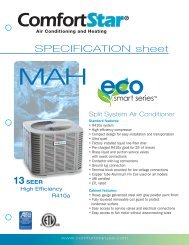Installation &Operation Instructions For R410A (MAH ... - ComfortStar
Installation &Operation Instructions For R410A (MAH ... - ComfortStar
Installation &Operation Instructions For R410A (MAH ... - ComfortStar
You also want an ePaper? Increase the reach of your titles
YUMPU automatically turns print PDFs into web optimized ePapers that Google loves.
CAUTION<br />
This system uses <strong>R410A</strong> refrigerant which operates at higher pressure than<br />
R-22. No other refrigerant may be used in this system. Gauge sets, hoses,<br />
refrigerant containers, and recovery system must be designed to handle<br />
<strong>R410A</strong>. If you are unsure, consult the equipment manufacturer.<br />
The outdoor unit must be connected to the indoor coil using field supplied refrigerant<br />
grade copper tubing that is internally clean and dry. Units should be installed only with<br />
the tubing sizes for approved system combinations. The charge given is applicable for<br />
total tubing lengths up to 25 feet.<br />
NOTE<br />
Using a larger than specified line size could result in oil return problems. Using<br />
too small a line will result in loss of capacity and other problems caused by insufficient<br />
refrigerant flow. Slope horizontal vapor lines at least 1" every 20 feet<br />
toward the outdoor unit to facilitate proper oil return.<br />
3.5 PRECAUTIONS DURING LINE INSTALLATION<br />
1. Install the lines with as few bends as possible. Care must be taken not to damage<br />
the couplings or kink the tubing. Use clean hard drawn Copper tubing where no<br />
appreciable amount of bending around obstruction is necessary, if soft copper must<br />
be used, care must be taken to avoid sharp bends which may cause a restriction.<br />
2. The lines should be installed so that they will not obstruct service access to the coil,<br />
air handling system or filter.<br />
3. Care must also be taken to isolate the refrigerant lines to minimize noise transmis-<br />
sion from the equipment to the structure.<br />
4. The vapor line and liquid line must be insulated with a minimum of 1/2" foam rubber<br />
insulation (Armafiex or equivalent). Tape and suspend the refrigerant lines as shown.<br />
DO NOT allow tube metal-to-metal contact. See Fig. 3.<br />
5. Use PVC piping as a conduit for all underground installations as shown in Fig. 4.<br />
Buried lines should be kept as short as possible to minimize the build up of liquid<br />
refrigerant in the vapor line during long periods of shutdown.<br />
6. Pack fiberglass insulation and a sealing material such as perma gum around refrig-<br />
erant lines where they penetrate a wall to reduce vibration and to retain some flexi-<br />
bility.<br />
7




